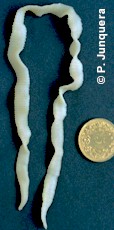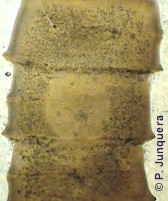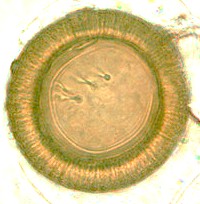Taenia is a genus of parasitic tapeworms  with about 100 species that affect dogs, cats, cattle, sheep, pigs and other livestock, many other wild and domestic animals as well as humans.
with about 100 species that affect dogs, cats, cattle, sheep, pigs and other livestock, many other wild and domestic animals as well as humans.
All species have final hosts where they complete development to adults and reproduce, and intermediate hosts where they spend part of their life cycle but cannot reproduce. The worms in the intermediate hosts are called cysticercoids or metacestodes.
Taenia species occur worldwide, whereby abundance and incidence in different regions depends on each particular species. As a general rule, they are more abundant in rural regions where dogs and cats can easily feed on raw offal and carcasses infected with cysticercoids.
The most important Taenia species of veterinary significance are the following:
In dogs as final hosts:
- Taenia hydatigena: also in cattle, sheep, goats and pigs as intermediate hosts, where the cysticercoids are called Cysticercus tenuicollis.
- Taenia krabbei: also in various deer species as intermediate hosts.
- Taenia multiceps: also in sheep as intermediate host, where the cysticercoids are called Coenurus cerebralis.
- Taenia ovis: also in sheep and goats as intermediate hosts, where the cysticercoids are called Cysticercus ovis.
- Taenia pisiformis and Taenia serialis: also in some rodents (e.g. rabbits, hares) as intermediate hosts.
In cats as final hosts:
- Taenia taeniaeformis: also in rodents (e.g. rabbits) as intermediate hosts.
In humans as final hosts
- Taenia saginata: also in cattle as intermediate host where it is called Cysticercus bovis.
- Taenia solium: also in pigs as intermediate hosts where it is called Cysticercus cellulosae.
The disease caused by these tapeworms in the final hosts is called taeniasis (this term is also used for all tapeworm infections). The disease caused in intermediate hosts is called cysticercosis.
Are animals infected with Taenia spp contagious for humans?
- NO. Dogs and cats infected with Taenia species are not contagious for humans, neither through contact, nor through the feces, because these species are not parasitic for humans.
- YES. Cattle and pigs infected with cysticercoids of Taenia saginata or Taenia solium are contagious for humans through ingestion of contaminated raw organs or meat. They are not contagious through simple contact or through the feces. For additional information read the chapter on the life cycle below.
You can find additional information in this site on the general biology of parasitic worms and/or tapeworms.
Final location of Taenia spp
Predilection site of adult Taenia species in the final hosts (dogs, cats, humans) is the small intestine.
Cysticercoids in intermediate hosts infect numerous organs, depending on the tapeworm species and the host: muscles, heart, liver, abdominal cavity, lungs.
Anatomy of Taenia spp

Most adult Taenia worms are usually large worms that can be several meters long (Taenia solium up to 50 meters in special circumstances) and up to 6 cm wide, depending on the species. They have a whitich color.
In most species the head (called scolex) is armed with hooks and suckers for attaching to the intestinal wall. The main body (or strobila) has hundreds and up to thousands of segments (called proglottids). Each segment has its own reproductive organs of both sexes (i.e. they are hermaphroditic) and excretory cells known as flame cells (protonephridia).
The reproductive organs in each segment have a common opening called the genital pore. In young segments all these organs are still rudimentary. They develop progressively, which increases the size of the segment as it is pushed towards the tail. Mature gravid segments are full of eggs (up to 100,000!) and detach from the strobila (i.e. the chain of segments) to be shed outside the host with its feces.
Otherwise, as other tapeworms, they have neither a digestive tube, nor a circulatory or respiratory systems. They don't need them because each segment absorbs what it needs directly through its tegument.
Mature gravid segments shed outside the host keep a certain motility that allows them to leave the feces into the surrounding environment (e.g. herbage). In some species they release the eggs rather quickly, in other species the eggs remain clustered waiting that a suitable host ingests them. Individual gravid segments can be up to 2 cm long and about 5 mm wide, i.e. easily visible by the naked eye.
The eggs of Taenia spp have an almost spherical shape and are quite small (30 to 40 micrometers). Each egg contains an already developed larva (oncosphere or hexacanth) with 3 pairs of hooks and is surrounded by a thick, striated shell. It is not possible to visually distinguish the eggs of the different Taenia species under the microscope, and they are also very similar to the eggs of Echinococcus granulosus and Echinococcus multilocularis, two other important tapeworms of pets and livestock.
Life cycle and biology of Taenia spp

Most Taenia species have an indirect life cycle with dogs, cats and humans (or other carnivores) as final hosts, and other domestic or wild animals (often livestock) as intermediate hosts.
In the final host (dogs, cats, humans) the eggs are shed with the feces, often still inside gravid segments that have detached from the worm's body. Sometimes a chain of gravid segments is shed that is visible by the naked eye in the feces of the host or on the skin around the anus.
The eggs are directly infective for the intermediate hosts and can remain infective for months in a moist and cool environment, but die quickly under dry and hot conditions. Eggs in hay may remain infective for several weeks!
The intermediate host (e.g. cattle, sheep, pigs, etc.) ingests the eggs with contaminated food or drinking water. In the host's gut the young larvae hatch out of the eggs, go through the gut's wall and reach the blood stream. They are then passively transported throughout the body. After being stopped in a capillary they develop to cysticercoids or bladder worms. They will not complete development to adult worms but remain there until a final host eats the intermediate host (or its offal).
The final host becomes infected when it feeds on offal contaminated with cysticercoids. In its gut the cysticercoids release the young worms (called protoscolices), which attach to the gut's wall and start producing segments (proglottids).
The prepatent period (time between infection and shedding of the first eggs) is 5 to 12 weeks and is species-specific. Inside a final host adult worms can survive for years.
Harm caused by Taenia spp, symptoms and diagnosis
The infection of dogs and cats with Taenia tapeworms is mostly benign and without clinical signs. If the number of adult tapeworms is high symptoms such as diarrhea or constipation, weight loss, restlessness, abdominal pain, and anal itching can be observed. Massive infections can cause bowel obstruction. Taenia tapeworms compete for the nutrients in the gut of the host, which may remain undernourished.
Diagnosis based on the detection of eggs in the feces not possible, because the eggs of the various Taenia species and those of other tapeworms (e.g. Echinococcus granulosus and Echinococcus multilocularis) are undistinguishable under the microscope. Diagnosis can be based on the examination of gravid segments that show a species-specific morphology.
Prevention and control of Taenia spp infections in dogs and cats
Although dogs and cats are not heavily affected by Taenia infections, they can easily transmit the disease to livestock (sometimes to humans as well).
In rural regions, especially in endemic ones, it is very important to keep domestic and working dogs as well as cats away from feeding raw offal or carcasses, and if possible also from hunting wild animals that can be infected (rabbits, other rodents, etc.). To this aim meat and other animal products that are fed to pets have to be thoroughly cooked or frozen at -20°C for 10 days to kill the cysticercoids. If this is not possible they should be given commercial pet food.
In endemic regions it is advisable to reduce the number of stray dogs and cats. It may be also appropriate to reduce the number of rodents using rodenticides, since they can also act as intermediate hosts of some Taenia species.
Several anthelmintic medicines are effective against Taenia infections. They contain active ingredients with broad-spectrum efficacy such as benzimidazoles (e.g. albendazole, fenbendazole, febantel, mebendazole) or specific taenicides such as praziquantel and epsiprantel, the latter often in combination with nematicides (e.g. levamisole, milbemycin oxime, pyrantel, etc.) to cover a broader spectrum of worms.
Most of these pet wormers are available in formulations for oral delivery either as solids (tablets, pills, etc.) or as liquids (drenches, suspensions, etc.). There are also a few injectable and spot-on (= squeeze-on = pipettes) taenicides in some countries (mainly with praziquantel).
Most wormers kill the worms shortly after treatment and are metabolized and/or excreted within a few hours or days. This means that they have a short residual effect, or no residual effect at all. As a consequence treated animals are cured from worms but do not remain protected against new infections. To ensure that they remain worm-free the pets have to be dewormed periodically, depending on age and the local epidemiological, ecological and climatic conditions.
Other classic livestock anthelmintics such as macrocyclic lactones (e.g. ivermectin, selamectin, etc.), levamisole, tetrahydropyrimidines (e.g. pyrantel, morantel) and piperazine derivatives are not effective at all against Taenia species or whatever tapeworms.
So far there are no antiparasitic medicines for external use such as shampoos, soaps, sprays, powders, insecticide-impregnated collars, etc. that control established tapeworm infections.
There are so far no vaccines against Taenia species. To learn more about vaccines against parasites of livestock and pets click here.
Biological control of Taenia tapeworms (i.e. using its natural enemies) is so far not feasible.
You may be interested in an article in this site on medicinal plants against external and internal parasites.
Resistance of Taenia spp to anthelmintics
So far there are no reports on resistance of Taenia spp to anthelmintics.
This means that if an anthelmintic fails to achieve the expected efficacy against this parasite, chance is very high that it is not due to resistance, but either the product was used incorrectly, or it was unsuited for the control of this parasite. Incorrect use is the most frequent reason for failure of antiparasitic drugs.
|
Ask your veterinary doctor! If available, follow more specific national or regional recommendations for Taenia spp control. |